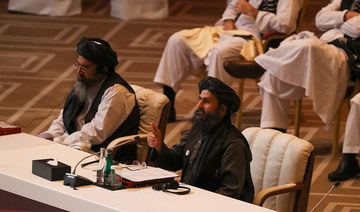KABUL: Afghan President Ashraf Ghani and the chairman of Afghanistan’s High Council for National Reconciliation, Abdullah Abdullah, will travel to the US later this week for their first meeting with President Joe Biden since he assumed office, officials said.
“The issues that will be discussed at the meeting will be bilateral ties and the peace process,” Feraidoon Khawzoon, a spokesman for Abdullah, told Arab News.
The meeting on Friday comes amid a phased withdrawal of US and NATO forces from Afghanistan, which began on May 1 and is scheduled to finish by September 11 in line with Biden’s order to end the “forever war.”
It follows a deadlock in US-sponsored peace talks between the Taliban and Kabul, and the Taliban’s steady victories on the battlefield in various parts of Afghanistan in recent weeks.
In a Twitter post on Monday, Abdullah said that he was “looking for constructive meetings and discussions on US-Afghan relations, and establishing a just and durable peace in Afghanistan.”
Officials in Ghani’s office could not confirm what the president expected to achieve from the talks.
However, Fatima Morchal, a spokeswoman for Ghani, told Arab News that he “would exchange views on the continuation of bilateral cooperation.”
The visit follows a March proposal by Washington for Ghani and Abdullah to form a new administration that would include the Taliban, amid a warning that the insurgent group would make rapid territorial gains once all foreign forces leave Afghanistan.
Ghani has long expressed his hope that Biden would review the troop withdrawal process, which is based on a controversial deal signed between the former US administration and the Taliban more than a year ago.
He also freed thousands of Taliban inmates — under pressure from former president Donald Trump — but vehemently rejected the idea of a new coalition government, vowing to pass the baton to the next administration following elections.
“In recent months, Ghani has pushed for a one-on-one audience with Biden to persuade him to keep some troops in Afghanistan,” an anonymous official told Arab News.
However, the Afghan president’s hopes were dashed on Sunday when White House Press Secretary Jen Psaki said that Biden “looks forward to welcoming” the Afghan leaders and reassuring them of US diplomatic, economic and humanitarian support for the turmoil-hit country as the drawdown continues.
“The visit by President Ghani and Abdullah will highlight the enduring partnership between the US and Afghanistan as the military drawdown continues,” she added.
Psaki further emphasized that Washington “continues to fully support the ongoing peace process and encourages all Afghan parties to participate meaningfully in negotiations to bring an end to the conflict.”
However, analysts have downplayed the importance of the upcoming meeting, warning that Washington is in favor of all-inclusive peace talks and will avoid solely backing Ghani’s government.
“This time, the Americans will make it clear to Ghani that he would lose US support if he pursues anti-peace agendas (failure to hand over power to an interim government based on intra-Afghan talks),” Abdul Satar Saadat, Ghani’s former legal adviser, told Arab News.
“The government is making propaganda about the visit, calling it as the start of a new chapter, but this meeting will be Ghani’s last meeting with Biden,” he added.
Ahmad Samin, a former World Bank adviser, agreed, adding that the president’s meeting with Biden will not “strengthen Ghani’s political image.”
“It is crystal clear that Ghani is not considered an ally of the US,” he told Arab News.
Samin further cited an example of a speech where Biden misspelled Ghani’s name as “Kayani,” a former army chief of Pakistan, to explain how “important” the Afghan president was to his US counterpart.
The Afghan visit comes amid a series of territorial gains by the Taliban in various regions of Afghanistan, including in the northern and northeastern areas, where they previously failed to establish a stronghold during their five-year rule, which ended with the US invasion of Afghanistan in late 2001.
The insurgents have captured dozens of districts in recent weeks, with both sides suffering heavy casualties, even as Afghan civilians continue to bear the brunt of the country’s protracted conflict.
The battlefield setbacks prompted Ghani to replace his security chiefs, including the head of the army, amid criticism that a lack of coordination was the reason for Taliban advances and a spike in casualties among government forces.
Following his appointment on Saturday, Defense Minister Gen. Bismillah Mohammadi called on Afghans to “cooperate with the troops in the war against advancing Taliban forces.”
Mohammadi, who fought under the late anti-Taliban commander Ahmad Shah Massoud during the civil wars in the 1990s, replaced Asadullah Khalid, who held the position since 2018.


























